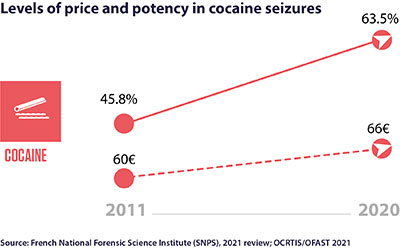
Cocaine and Crack
 Overview
Overview
Cocaine (or cocaine hydrochloride) is an alkaloid extracted from the coca leaf. A powerful central nervous system stimulant, this molecule acts on the dopaminergic, serotonergic and adrenergic systems. It comes in the form of a white powder, most often consumed through the nose (snorting), sometimes through the lungs (inhaling smoke or vapours orally or nasally) or intravenously (injection).
Cocaine base, which circulates under the name “crack” or “free base cocaine”, is a derivative of cocaine hydrochloride, resulting from the addition of bicarbonate or ammonia. This transformation allows the powder to crystallise into small rocks, which are then smoked and, more rarely, injected. The effects of cocaine base are much stronger than those of cocaine hydrochloride. Their onset is faster (1-2 minutes compared to 15-30 minutes), but their duration is much shorter (10-15 minutes compared to about an hour), which leads users to take them more often.
Reference
- Canarelli T., Lermenier A., Dambélé S. Carte d'identité de la cocaïne [Cocaine profile], in Pousset M. (Dir.), Cocaïne, données essentielles. Saint-Denis, OFDT, 2012, p. 11-17.
 Production/supply
Production/supply
Seizures
Cocaine seizures have been increasing in France for the past thirty years. While in the 1990s these averaged more than 1.8 tonnes per year, they rose to 5.3 tonnes in the 2000s and to more than 11 tonnes in the 2010s.
In 2021, seizures reached a record high of 26.5 tonnes vs 13.1 tonnes in 2020. This development is the result of several factors:
- The very strong growth in cocaine production in Latin America, and particularly in Colombia, where most of the cocaine hydrochloride consumed in France comes from. From the beginning of the 2010s, production in this country more than tripled from 384 tonnes in 2011 to 1 228 tonnes in 2020;
- The diversification of cocaine routes with the significant role of the French West Indies as transit zones to metropolitan France and more recently of French Guiana as a direct source through mule trafficking.
Reference
- EMCDDA (2021) European Drug Report 2021: trends and developments. Luxembourg, Publications Office of the European Union, 60 p.
Content and price

A very clear increase in the purity of cocaine has been observed over the last ten years, with the average rate observed on French territory by the scientific police department (SNPS) currently reaching 63.5% vs 45.8% in 2011. The cocaine sold frequently contains cutting agents that also have psychoactive effects (levamisole, paracetamol, caffeine, hydroxyzine, lidocaine).
The price of a gram of cocaine hydrochloride has been falling steadily since 2018. The going price fell from €70 per gram to €66 according to the French Anti-Narcotics Office (OFAST). The accessibility of cocaine has been facilitated by fractional sales (by the half-gram at €30 or €40 or for small sums: sachets or “pochons” are sold for €15 or 20).
The price of a crack cocaine “wafer” (which can allow 3 to 5 uses) varies between €10 and €20. The cocaine sold and already free based (crack) is used exclusively in the Paris region and in the French West Indies. In metropolitan France, crack cocaine is sold in Paris in the north-east of the capital and in Seine-Saint-Denis.
References
- Gérome C., Gandilhon M. Psychoactive substances, users and markets - Recent trends (2019-2020). Tendances, OFDT, 2020, no. 141, 8 p.
- Cadet-Taïrou A., Jauffret-Roustide M., Gandilhon M., Dambélé S., Jangal C. Main results of the Crack study in the Ile-de-France region. Overview. Paris, OFDT, 2021, 20 p.
 Use
Use
Increasingly rare use in the general population
Cocaine, in its hydrochloride form, is the most widely used illicit product in France after cannabis: the number of lifetime cocaine users in France among 11–75-year-olds was estimated at 2.1 million people in 2017. The share of 18-64-year-olds who had used cocaine before quadrupled in two decades (from 1.2% in 1995 to 5.6% in 2017).
Use during the past year was reported by 600 000 people. Both current use (use in the last year) and lifetime use were still two to three times more common among men than women. Use over the course of the last year was highest among 18-25-year-olds (2.8%) and 26-34-year-olds (3.4%), and then declined and disappeared after age 55.
In 2017, among 17-year-olds, the level of lifetime cocaine use was 2.8% (2.4% for girls and 3.1% for boys). In the same population, lifetime crack cocaine use was marginal at 0.6%.
An estimate produced from data from specialised drug treatment centres (CSAPA) estimated that 42 800 (40 900-44 700) of 15-64-year-olds in France used cocaine in 2019, compared with 12 800 (12 000-14 000) in 2010. Furthermore, in harm reduction facilities (CAARUD), between 2015 and 2019, the proportion of people reporting cocaine use (hydrochloride or free base) in the past month rose from 50 to 69%.
References
- Cadet-Taïrou A., Janssen E., Guilbaud F. Profils et pratiques des usagers reçus en CAARUD en 2019. [Profiles and practices of users received at the CAARUD in 2019.] Tendances, OFDT, 2020, no. 142, 4 p.
- OFDT, Le Nézet O., Martinez M., Gérome C., Gandilhon M., Janssen E. Drugs workbook, In OFDT (Dir.), 2021 National report (2020 data) to the EMCDDA by the Reitox National Focal Point France. Paris, OFDT, 2021, 38 p.
- Spilka S., Le Nézet O., Janssen E., Brissot A., Philippon A., Shah J., Chyderiotis S. Drug use in 17-year-olds: analysis of the 2017 ESCAPAD survey. Tendances, OFDT, 2018, no. 123, 8 p.
- Spilka S., Richard J.-B., Le Nézet O., Janssen E., Brissot A., Philippon A., Shah J., Chyderiotis S., Andler R., Cogordan C. Levels of illicit drug use in France in 2017. Tendances, OFDT, 2018, no. 128, 6 p.
 Consequences
Consequences
Cocaine and crack cocaine use, whether occasional or chronic, can have an impact on users’ physical and mental health. These consequences can occur regardless of the route of administration, amount and frequency of use.
In terms of effects, cocaine is often described as a disinhibitor that induces feelings of omnipotence and hyperactivity. The effects described are also an increase in emotions as well as excitement and a feeling of euphoria. The effects sought by users also include a sense of achievement and enjoyment.
The somatic complications most often encountered are cardiac or neurological (stroke, convulsions, etc.). Pulmonary complications occur almost exclusively among crack cocaine users, due to the method of use (vapour inhalation).
Snorting cocaine causes damage to the nasal septum, sometimes rapidly in the case of heavy use, and can also cause oral anaesthesia. Finally, the risky practices associated with injecting and sharing equipment (straws for cocaine, pipes for crack) can cause bacterial infections (local skin abscesses, septicaemia) or viral infections (HIV, HBV and especially HCV).
In addition, in the hours following cocaine use, outbreaks of paranoia, anxiety, aggression and violence may appear, sometimes associated with auditory, visual and sensory hallucinations. Cocaine-induced paranoia can be accompanied by a compulsive drug-seeking syndrome, especially among crack cocaine users.
Cocaine does not cause physical dependence, but it does generate a strong psychological dependence.
Access to care
In CSAPAs, between 2015 and 2019, the proportion of patients treated for cocaine or crack/free base cocaine use increased from 10% to 18% and from 3.9% to 9.6% respectively. Among the outpatient admissions of people treated in CSAPAs in 2019, patients for whom cocaine is the substance of abuse that poses the most difficulties represent 4.6% of the people treated (i.e. 14 500 people in 2019 compared to 7 900 in 2015).
References :
- Palle C. Les personnes accueillies dans les CSAPA : situation en 2019 et évolution sur la période 2015-2019 [People received at the CSAPA. Situation in 2019 and evolution over the period 2015-2019], Tendances no. 146, OFDT, 2021, 6 p.
Cocaine-related deaths on the rise
The involvement of cocaine, at least in part, in deaths related to drug and substance abuse has increased in recent years, from 9% to 22% of deaths between 2013 and 2019, or 110 deaths in 2019 (2019 DRAMES Survey data, CEIP-A Grenoble-ANSM).
 Perceptions /opinions
Perceptions /opinions
Perception in the general population
According to EROPP, the survey on representations, opinions and perceptions regarding psychoactive drugs, more than three-quarters of French people (76%) aged between 15 and 75 considered cocaine to be a dangerous drug from the moment of first use, second only to heroin. The proportion of people who hold this view fell for the first time since 1999 (85% in 2013). Despite the widespread use of this drug among the population and the fairly positive image it still enjoys in some circles, opinions about it, like other products (especially licit ones), have hardened in recent years. Thus, 82% of French people believe that cocaine users are dangerous for those around them and many refuse to exonerate them from their share of responsibility, on the pretext of an illness or difficult family history.
Reference :
- Spilka S., Le Nézet O., Janssen E., Brissot A., Philippon A., Chyderiotis S. Drugs: perceptions of substances, public policies and users. Tendances, OFDT, 2019, no. 131, 8 p.
 Legal framework and recent public policies
Legal framework and recent public policies
Cocaine, whether snorted or smoked, in powder (cocaine hydrochloride) or base (crack, free base cocaine) form, is a classified drug and its use is prohibited. Buying, using, possessing, giving away, dealing, producing, transporting or driving after using cocaine are all offences against the law and are subject to severe penalties in court, regardless of the amount of product involved.
The law provides for the repression of trafficking and profits from trafficking, which has been reinforced by some thirty laws since the late 1990s. Penalties have been increased to life imprisonment for certain drug trafficking offences and high fines (up to €7.5 million for the production, manufacture, import, transport or sale of drugs).
Last update: September 2022
Drugs in Europe
![]() 2023 EMCDDA European Drug Report
2023 EMCDDA European Drug Report
The European Drug Report 2023: Trends and Developments presents the EMCDDA’s latest analysis of the drug situation in Europe. Focusing on illicit drug use, related harms and drug supply, the report contains a comprehensive set of national data across these themes and key harm-reduction interventions. This report is based on information provided to the EMCDDA by the EU Member States, the candidate country Türkiye, and Norway, in an annual reporting process.
The annual Statistical Bulletin contains the most recent available data on the drug situation in Europe provided by the Member States. These datasets underpin the analysis presented in the European Drug Report. All data may be viewed interactively on screen and downloaded in Excel format.
![]() The European Union and the drug phenomenon
The European Union and the drug phenomenon
 The European Union & the drug phenomenon : Frequently asked questions, joint publication between the EMCDDA and the European Commission, october 2010, 12 p.
The European Union & the drug phenomenon : Frequently asked questions, joint publication between the EMCDDA and the European Commission, october 2010, 12 p.



